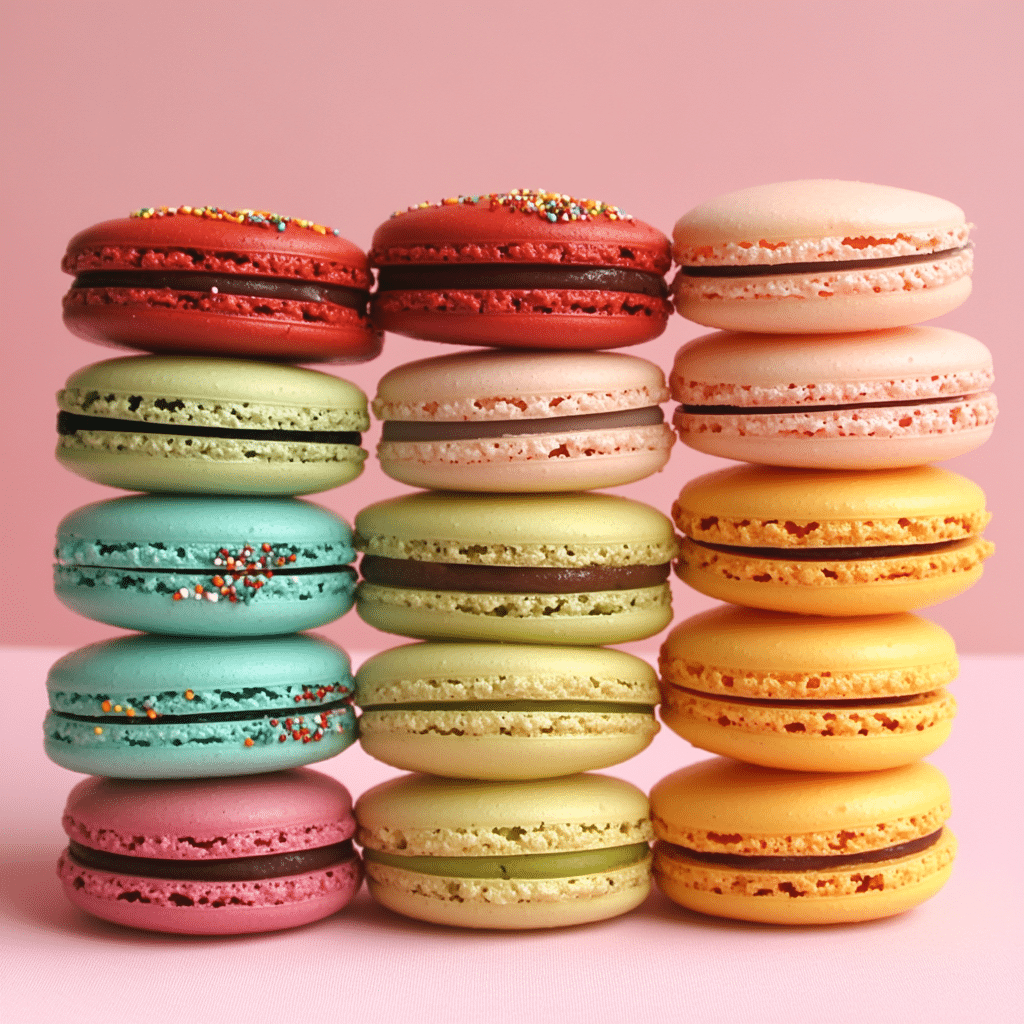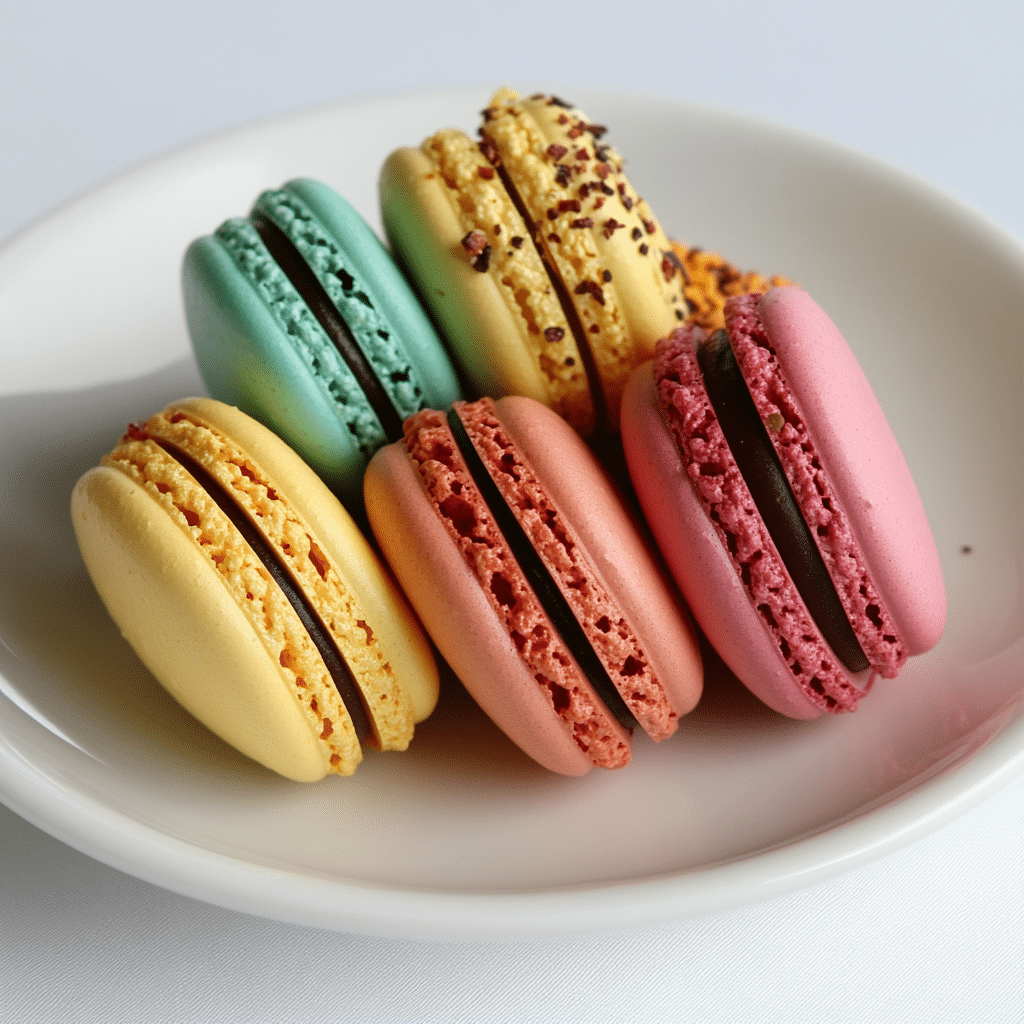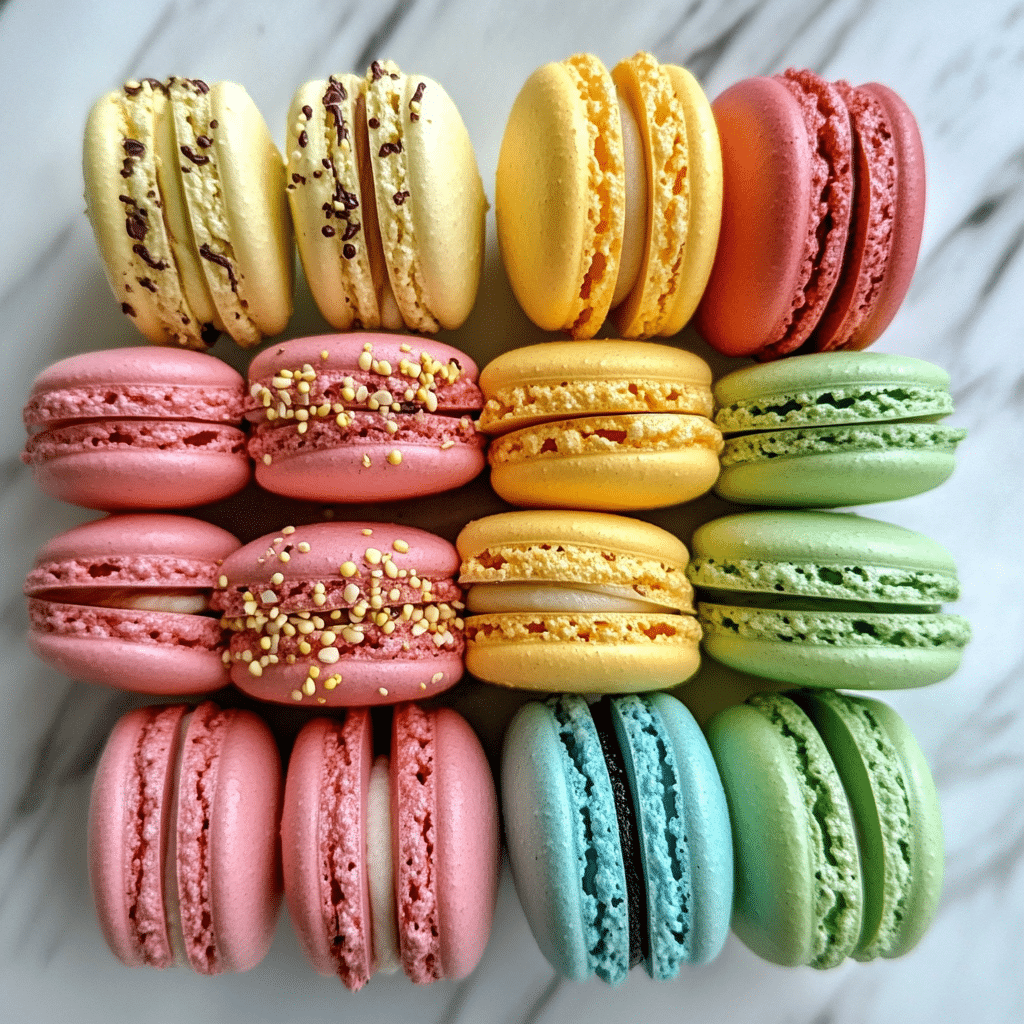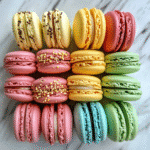Light, airy, colorful, and irresistibly elegant—French macarons are more than just a sweet treat; they’re a symbol of French sophistication and global dessert obsession. From Instagram-worthy dessert tables to high-end bakeries, macarons have become a beloved indulgence across the United States. But what really makes a macaron French? Is it the method, the ingredients, or simply the finesse?
In this guide, we’re diving deep into everything you need to know about French macarons—how they’re made, what sets them apart, their health profile, and even how to avoid common baking mistakes. We’ll also uncover how this delightful cookie found its way from Parisian cafés to TikTok trends.
Don’t miss our Ultimate Guide to Cotton Candy Macarons—perfect if you’re craving a sweet twist on the classic.
1. What Is a French Macaron?
What Defines a Traditional French Macaron?
A French macaron is a delicate sandwich cookie made from almond flour, egg whites, and powdered sugar. Each macaron has two smooth, domed shells with a ruffled “foot” and a soft, chewy interior. Sandwiched between these shells is a creamy or fruity filling—often ganache, buttercream, or jam.
What distinguishes French macarons from other cookies is the meringue base. The cookie is crisp on the outside and tender on the inside, with a flavor profile that balances sweetness and subtle nuttiness. The classic preparation is known as the French meringue method, although some bakers use the Italian meringue technique for better stability.
Macarons come in a wide range of colors and flavors—from traditional pistachio and raspberry to trendy matcha and cotton candy. Despite their small size, they require precision, patience, and practice to perfect.
Brief History of the French Macaron: From Italy to Paris
The origin of the French macaron dates back to the 16th century when Queen Catherine de Medici brought Italian pastry chefs to France. These early versions were simple almond cookies without fillings.
It wasn’t until the 20th century that Pierre Desfontaines, a pastry chef at Ladurée in Paris, introduced the idea of filling two shells with ganache—creating the French macaron we know and love today. Since then, French patisseries have elevated the macaron into a gourmet icon, with bakeries like Ladurée and Pierre Hermé gaining international acclaim.
French macarons later gained popularity in the United States, thanks to food blogs, TV shows, and social media. Today, they’re a must-have at weddings, birthdays, and upscale dessert bars.
2. French Macaron vs Macaroon – What’s the Difference?
Key Differences in Ingredients, Texture, and Appearance
It’s one of the most common dessert confusions—macaron vs. macaroon. Though the names sound nearly identical, these two treats couldn’t be more different.
| Feature | French Macaron | Macaroon (Coconut Cookie) |
|---|---|---|
| Base Ingredients | Almond flour, egg whites, sugar | Shredded coconut, egg whites, condensed milk |
| Texture | Crisp outside, chewy inside | Soft and chewy throughout |
| Appearance | Smooth shell with ruffled feet | Rough, lumpy texture |
| Filling | Buttercream, ganache, or jam | Usually none or sometimes dipped in chocolate |
| Origin | France (inspired by Italy) | Italy, popular in Jewish cuisine |
French macarons are delicate sandwich cookies that require exact measurements and techniques. They are light and elegant with a pastel aesthetic.
Macaroons, on the other hand, are dense coconut mounds that are much simpler to prepare. While both are gluten-free and made with egg whites, they deliver very different flavor and texture experiences.
Why the Confusion Exists and How to Remember the Difference
The confusion often stems from the similar spelling and pronunciation of the two words. “Macaron” (pronounced mack-a-rohn) is French, while “macaroon” (pronounced mack-a-roon) is the English version that often refers to the coconut-based treat.
Here’s an easy way to remember:
- One “o” = French macaron (fancy, filled, almond-based)
- Two “o”s = Coconut macaroon (chunky, chewy, coconut)
Once you try both, you’ll never mix them up again.

3. Key Ingredients in French Macarons
Core Ingredients Every Authentic Macaron Needs
Creating authentic French macarons starts with a shortlist of high-quality ingredients. Simplicity is key, but there’s no room for shortcuts. Each element plays a crucial role in texture, structure, and flavor.
Essential Ingredients:
- Almond Flour – Finely ground and sifted, almond flour gives macarons their signature nutty flavor and smooth finish. Avoid almond meal, which has a coarser texture.
- Egg Whites – Whipped into a meringue, egg whites provide the lift and airy texture. Aged egg whites (separated and left in the fridge for 1–2 days) are preferred for stability.
- Granulated Sugar – Added to the egg whites during whipping to stabilize the meringue.
- Powdered Sugar – Mixed with almond flour to create a smooth, sweet dry base.
- Food Coloring (Optional) – Gel-based coloring is best to avoid altering the batter consistency.
These five ingredients form the base of the French macaron shell. From there, creativity shines in the fillings, which can be made from:
- Buttercream – Ideal for sweet, smooth finishes.
- Ganache – A richer, chocolate-based filling.
- Fruit Jam or Curds – For a tangy contrast to the sweet shell.
Pro Tip: Always sift your dry ingredients and avoid overmixing the batter during macaronage. This helps you achieve the ideal consistency that leads to smooth tops and prominent “feet.”
Tips for Sourcing Quality Ingredients for Better Flavor and Color
The magic of a macaron lies in its balance. That means your ingredients must be fresh, fine, and flavorful.
- Almond flour should be blanched, finely ground, and stored in a cool place to prevent oil separation.
- Use organic or pasture-raised eggs if possible. Their whites whip better and more consistently.
- When using colorants, opt for professional-grade gel or powder colors. Avoid liquid dyes, which can alter the batter’s balance.
For added flair, explore natural additions like freeze-dried fruit powder for flavor and hue, or culinary lavender for floral notes.
Don’t miss our Chocolate & Coated Treats for inspiration on unique macaron fillings with gourmet flair.
4. The Art and Science of Making French Macarons
Step-by-Step Process for Making Macarons at Home
Mastering the French macaron is no small feat, but once you understand the steps, it becomes a deeply rewarding (and delicious) craft. Here’s a simplified yet accurate breakdown of the macaron-making process using the French meringue method.
- Sift Dry Ingredients
Combine almond flour and powdered sugar in a bowl. Sift the mixture at least twice to remove any lumps. This ensures smooth, bump-free tops on your macarons. - Whip the Meringue
Beat room-temperature egg whites until foamy. Gradually add granulated sugar and continue whipping until stiff, glossy peaks form. You can add gel food coloring at this stage. - Macaronage (Mixing)
Fold the almond mixture into the meringue gently. This is where most bakers go wrong. You want a smooth, lava-like consistency that flows slowly and forms ribbons. - Piping the Batter
Using a piping bag with a round tip, pipe uniform circles onto a silicone baking mat or parchment-lined tray. Tap the tray to release air bubbles. - Rest the Shells
Let the piped batter rest for 30–60 minutes until a thin skin forms on the surface. When touched, it should not stick to your finger. - Bake
Bake at 300°F (150°C) for 12–14 minutes. The macarons should develop “feet” (ruffled edges at the base) and rise without browning. - Cool and Fill
Once cooled, pair shells by size. Pipe your choice of filling—ganache, buttercream, or jam—onto one side and sandwich them gently. - Mature (Optional but Recommended)
Let the filled macarons sit in the fridge for 24–48 hours. This aging process enhances flavor and texture.
Common Mistakes to Avoid When Baking Macarons
Macarons are as fragile in preparation as they are in bite. Avoid these frequent pitfalls:
- Overmixing or undermixing: Overmixing leads to flat macarons. Undermixing results in cracked shells.
- Skipping the resting period: Without a dry skin, macarons will crack in the oven.
- Oven too hot: High temperatures can cause hollow shells or browning.
- Improper meringue: Weak peaks won’t hold structure.
Practice makes perfect, and once you get the hang of it, baking macarons at home becomes a joy.
Looking for inspiration? Try Gummies & Chews for colorful sweets to pair with your macarons.
5. Flavor Variations and Fillings

Popular Flavors from Raspberry to Pistachio
French macarons come in an astonishing variety of flavors—each one crafted to deliver a burst of unique taste in a single bite. Some of the most beloved options include:
- Raspberry – Tangy jam with a pink shell
- Pistachio – Nutty, slightly savory, and vibrant green
- Vanilla Bean – Classic and rich
- Salted Caramel – Sweet with a buttery finish
- Lemon – Zesty and refreshing
- Coffee – Bold and bittersweet
- Lavender – Floral and light
- Matcha – Earthy and trendy
Artisan patisseries also experiment with creative flavors like rose lychee, churro, or champagne. These seasonal or limited-time releases often gain viral popularity on social media.
How to Make Ganache, Buttercream, and Jam Fillings
Your choice of filling defines the overall flavor and texture of a French macaron. Here’s how to make three common fillings at home:
1. Ganache (Rich & Creamy)
- 1/2 cup heavy cream
- 4 oz dark or white chocolate
- Optional flavor: espresso, fruit purée, peppermint oil
Heat the cream, pour over chocolate, let sit for 2 minutes, then stir until smooth.
2. Buttercream (Sweet & Fluffy)
- 1/2 cup unsalted butter
- 1.5 cups powdered sugar
- 1–2 tbsp heavy cream or milk
- Vanilla or almond extract
Beat until light and airy. Add flavors or colors as desired.
3. Jam or Curd (Tangy & Fresh)
Use store-bought or homemade fruit jam. Reduce excess moisture for a thicker spread. Great for flavors like raspberry, blueberry, or lemon.
Experimenting with fillings is where bakers can show off creativity. Just remember—the shell should complement, not overpower, the filling.
6. Are French Macarons Healthy or Indulgent?
Nutritional Breakdown of a Macaron (Calories, Sugar, Fat)
While elegant and petite, French macarons are not exactly health food. A standard macaron weighs around 10–15 grams and contains:
| Nutrient | Per 1 Macaron (avg.) |
|---|---|
| Calories | 70–100 |
| Sugar | 10–14g |
| Fat | 3–6g |
| Protein | 1g |
| Carbs | 10–15g |
| Gluten-Free? | Yes (naturally) |
They’re lower in calories than many frosted cupcakes or chocolate bars, but the high sugar content and fat (from butter or chocolate) still classify macarons as an indulgence.
Are There Healthier or Allergen-Friendly Alternatives?
Yes! Macaron recipes can be adjusted to suit dietary preferences or restrictions:
- Vegan macarons use aquafaba (chickpea brine) instead of egg whites.
- Sugar-free options substitute erythritol or monk fruit for sugar.
- Nut-free versions are possible with pumpkin seed or sunflower flour—though the texture changes.
That said, even standard macarons are naturally gluten-free, making them a safer treat for people with gluten sensitivities.
7. Serving and Storing French Macarons Properly
Best Practices for Serving at Parties and Events

French macarons are a favorite for weddings, baby showers, birthdays, and upscale dessert bars. Their colors and versatility make them perfect for themed events, whether you’re going for romantic blush tones or bold modern palettes.
To serve them right:
- Use macaron towers or acrylic trays to keep them upright and visually appealing.
- Offer multiple flavors to give guests variety.
- Pair them with drinks—champagne, espresso, or sparkling water bring out different flavor notes.
Pro Tip: Macarons should be served at room temperature. If you’ve stored them chilled, let them sit out for 15–20 minutes before serving. This allows the filling to soften and the shell to regain its ideal chew.
Storing Tips to Maintain Texture and Flavor
Storing macarons correctly ensures they remain as delightful as the moment you made (or bought) them.
Short-term storage:
- Place in an airtight container in the fridge. They’ll last up to 5 days.
- Store different flavors separately to prevent scent transfer.
Long-term storage:
- Macarons can be frozen for up to 1 month. Place in layers with parchment between each, sealed tightly in a freezer-safe container.
- Thaw in the fridge overnight, then bring to room temp before serving.
Avoid humid environments, which can soften the shells and cause fillings to bleed.
8. Where to Buy the Best French Macarons
Popular Bakeries in the USA and Online Shops
If baking macarons sounds intimidating (and hey, no shame in that!), there are plenty of top-tier patisseries across the U.S. offering professionally made French macarons:
| Bakery | Location | Signature Flavor |
|---|---|---|
| Ladurée | NYC, Miami, Beverly Hills | Rose, Salted Caramel |
| Bottega Louie | Los Angeles | Birthday Cake |
| Dana’s Bakery | Online + NJ | Fruity Cereal, Red Velvet |
| Macaron Café | NYC + Nationwide Delivery | Pistachio, Espresso |
For online ordering:
- Dana’s Bakery and Macaron Café offer nationwide shipping with safe packaging.
- Many Etsy sellers now craft gourmet-style macarons with unique, seasonal flavors.
When ordering online, ensure they offer climate-controlled packaging during hot seasons to avoid melting or breakage.
How to Spot High-Quality Macarons When Shopping
Look for:
- Smooth, shiny shells without cracks
- Well-formed feet
- Even height on both sides
- A balanced filling (not overstuffed, not hollow)
Fresh macarons should be soft inside without being mushy and have a subtle almond aroma.
9. French Macarons in Pop Culture & Social Media
Why French Macarons Are Trending on Instagram & TikTok
Search #frenchmacaron on Instagram or scroll through TikTok, and you’ll see beautifully decorated pastel treats garnished with gold leaf, edible flowers, or themed character art.
Why the buzz?
- Their aesthetic appeal makes them ideal for social media
- Creators show off satisfying piping and filling videos
- Their customizable nature fits every trend—from K-pop to Bridgerton
The rise of macaron classes, DIY kits, and macaron ASMR content has made them a digital sensation. Social trends have also inspired flavors like churro, pumpkin spice, and unicorn swirl.
Macaron-Inspired Products, Cafes, and Events in the U.S.
Beyond the dessert itself, macarons have inspired a wave of branded merchandise—think macaron-shaped candles, keychains, and even bath bombs.
You’ll also find macaron cafes in cities like:
- New York
- Los Angeles
- Seattle
- Austin
These cafes don’t just serve macarons—they offer latte pairings, afternoon tea experiences, and dessert flights featuring up to a dozen macaron flavors.
FAQ
What are the ingredients in French macarons?
Traditional French macarons use almond flour, egg whites, powdered sugar, granulated sugar, and optional gel food coloring. Fillings vary but commonly include buttercream, ganache, or jam.
What is the difference between macarons and French macarons?
Technically, “macaron” and “French macaron” are the same. However, the term “French macaron” is often used to distinguish it from the coconut macaroon—a denser, sweeter, coconut-based cookie.
What is special about French macarons?
French macarons are known for their elegant texture—crisp on the outside, soft and chewy inside—and their endless flavor possibilities. They’re also gluten-free and visually striking.
Are French macarons unhealthy?
While not as high in calories as some desserts, macarons contain sugar and fat. One macaron typically has 70–100 calories. They’re best enjoyed in moderation.
How many calories are in 1 macaron?
Depending on size and filling, one French macaron contains around 70–100 calories.
For more recipes follow me on PINTEREST
PrintFrench Macaron – The Ultimate Guide to This Iconic French Delight
Delicate, crisp on the outside and chewy inside, these classic French macarons are a Parisian favorite that melt in your mouth. This foolproof recipe delivers perfectly smooth shells and endless flavor possibilities—from vanilla to raspberry, pistachio, and beyond.
- Prep Time: 30 minutes
- Cook Time: 55 minutes
- Total Time: 1 hour 30 minutes
- Yield: 20 macarons 1x
- Category: candy
- Cuisine: american
Ingredients
Shells:
-
1 cup (100g) almond flour (blanched, finely ground)
-
1 3/4 cups (200g) powdered sugar
-
3 large egg whites (room temperature)
-
1/4 cup (50g) granulated sugar
-
Gel food coloring (optional)
Buttercream Filling (Basic Vanilla):
-
1/2 cup (1 stick) unsalted butter, softened
-
1 cup powdered sugar
-
1 tsp vanilla extract
-
1–2 tbsp heavy cream
Instructions
-
Sift almond flour and powdered sugar together. Repeat for extra smoothness.
-
Whip egg whites until foamy, gradually add granulated sugar and beat to stiff, glossy peaks. Add food coloring if desired.
-
Fold dry mixture into meringue carefully (macaronage stage). Batter should flow slowly like lava.
-
Pipe 1-inch rounds onto parchment-lined baking sheet using a piping bag with a round tip. Tap trays to remove air bubbles.
-
Rest shells for 30–45 minutes until they form a skin (you should be able to touch them lightly without sticking).
-
Bake at 300°F (150°C) for 12–15 minutes. Cool completely before filling.
-
Make buttercream: Beat butter until fluffy. Add powdered sugar, vanilla, and cream until smooth.
-
Assemble macarons: Pipe filling onto one shell, sandwich with another.
-
Mature in fridge for 24 hours for best texture and flavor. Bring to room temperature before serving.
Nutrition
- Serving Size: 20 macarons
- Calories: 90–100 kcal
- Sugar: 11g
- Fat: 5g
- Carbohydrates: 12g
- Protein: 1g


